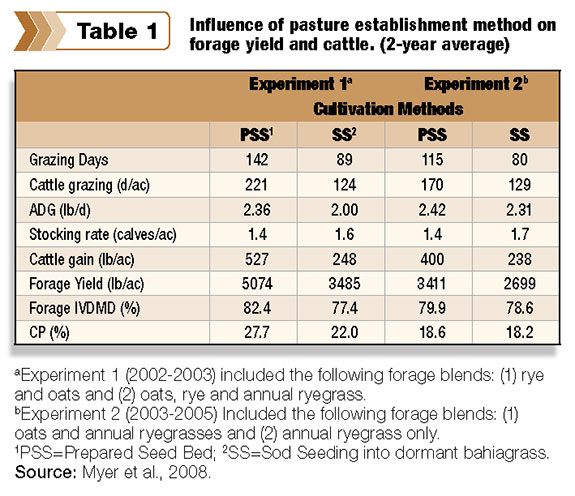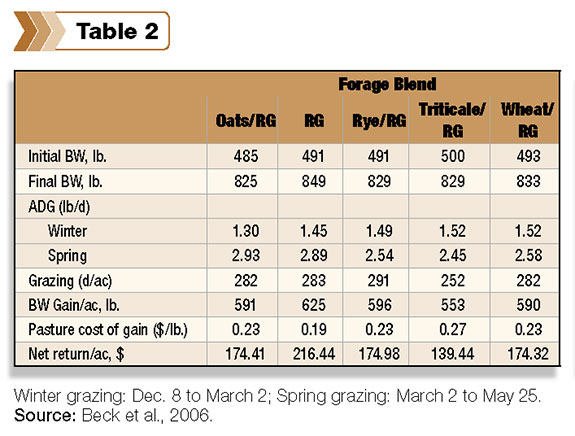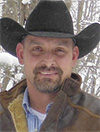There is a large advantage in overall forage production of cool-season pastures by using a prepared seedbed compared to sod-seeding into dormant warm-season pastures.
However, many beef cattle producers do not have open land or equipment available to plant cool-season annual pastures in a prepared or clean-tilled seedbed.
Sod-seeding or overseeding cool-season forages in bermudagrass or bahiagrass sward provides a method for enhancing forage production and extending the grazing season.
The term overseeding is commonly used to describe broadcast seeding of winter annual forage crops over the sods of perennial summer grasses with or without tillage.
This type of forage management practice allows extending land use and forage production to eight or 10 months instead of six to eight months, which helps reduce hay and feed supplementation.
Winter annuals produce higher-quality forage than summer perennial grasses, which helps improve animal nutrition. Previous studies in Alabama have shown that sod-seeding coastal bermudagrass pasture with annual ryegrass extended the number of available grazing days per acre from 72 to 97.
There are cool-season forages available for sod-seeding or overseeding into warm-season pastures that can provide a relatively stable level of production from mid-winter through early summer.
Annual ryegrass, clovers and small grains (wheat, oats, barley, rye and triticale) are commonly used in winter grazing systems. Most of these forages could be planted as monocultures or blends.
These forages are more productive at a time that coincides with breeding or calving seasons for many cow/calf operations. Understanding when various winter forages are most productive is important in designing a forage program that best suits livestock and the crop enterprise.
Availability of winter forage depends on a number of environmental conditions, including rainfall and temperature. When deciding what species and varieties to include in a winter grazing system, obtaining information from the state forage variety trial close to the location of production is advised.
Planting method (no-till drill, light disking or broadcast) will also greatly influence when the forage will be available for grazing.
When planting into an existing sod, it is critical for the warm-season perennial grass to be as short as possible (1 to 2.5 inches) and less competitive to the overseeded cool-season annual by using a hay harvest, grazing or mowing.
Mowing may not be a good option if the grass is very tall, since the cut grass will act as mulch and shade the soil surface. If seed are broadcast on a lightly disked sod, some type of drag should be used to help cover the seed.
No-till drills are equipped with fluted coulters that cut a slit in undisturbed sod followed by some type of opener that places the seed in the slit.

Another practice to reduce the warm-season grass competition is a light disking about one to two inches deep.
Using this method might make the recovery of the perennial grass slower in the spring (Figure 1).
One option with this method is to turn the blades on the disc almost straight to make alternating strips (four to five inches wide) of disked and undisked sod.
This practice can be used on all warm-season perennial grasses, with improved spring recovery compared to complete disking.
Another advantage to light disking is that it provides some loose soil for covering the seed and helps ensure good seed/soil contact.
Chemical desiccants have been used to reduce warm-season grass competition.
Paraquat activity is rapid with complete desiccation in 24 hours. Warm-season perennial grasses initiate new growth within days after application. Complete desiccation with paraquat takes about a week after application.
Glyphosate can be phytotoxic to warm-season grasses, often resulting in some stand loss. For good desiccation, at least six to eight inches of top growth is required for glyphosate absorption and translocation, which must be mowed or burned off before overseeding.
Overseeding of cool-season annuals should be delayed until one day after paraquat application and two weeks after glyphosate application.
Use of desiccants on warm-season perennial grasses is an added cost and does not always improve early production of the cool-season forage.
Without disking or the use of desiccants, planting should be delayed until night temperatures are consistently below 50°F to slow growth of the warm-season perennial grass.
Seeding rates are usually a major consideration to obtain a quick ground cover. Using a drill places a higher percentage of the seed at the proper planting depth, resulting in better stands than broadcasting the seed and covering them with a drag or packer.
Seeding rates should be increased from 25 to 35 percent when broadcasting seed to get the same stand density as drilling the seed.
When a small grain-ryegrass mixture is planted, the normal seeding rates are used with 20 to 25 pounds per acre of ryegrass and 60 to 90 pounds of small grains.
For legume-ryegrass mixtures, from 15 to 20 pounds of ryegrass is planted with two-thirds the recommended seeding rate for a pure stand of the legume.
Annual ryegrass and most legumes can be mixed with the first fertilizer application and broadcast on a lightly disked or undisturbed grass sod.
Caution: It is important that the fertilizer and seed be spread within six to eight hours of mixing or reduced germination and seedling vigor may occur.
Unless spreading is prompt, survival of the rhizobia on the legume seed may also be adversely affected. Usually small grains are more desirable for early planting than other winter annuals.
The date of planting winter annuals on sod should be later than the date of planting on prepared land. If winter annuals are planted on sod too early, the summer grass will continue to grow and compete with the winter annual seedlings.

Generally, winter annuals planted into warm-season grass sod will produce forage three to four weeks later than when planted into a clean tilled seedbed, which could affect forage production, grazing days and animal daily gains (ADG) (Table 1).
Winter annuals can be used as hay, silage or pasture; however, overseeding winter annuals does not provide much fall or early winter grazing.
Winter annuals should not be grazed until they have developed a secondary root system to help anchor the plant and prevent livestock from uprooting it while grazing (usually eight to 10 inches tall).
Limit-grazing is a system many livestock producers follow to make efficient use of winter pastures during mid-winter.
Overseeded areas should be stocked heavily in the spring to make use of the forage and to make sure the winter annuals do not “shade out” the summer grass.
However, a hay or baleage cutting can sometimes be obtained in mid-April to May if cattle stocking rates are not adequate to keep up with rapid grass growth.
Some of the disadvantages of using baleage include increased harvest cost due to plastic, shorter storage life and higher spoilage potential.
The selection of which cool-season annual combinations to interseed into warm-season grass sod is dependent on climatic conditions.

A study conducted at University of Arkansas indicated that interseeding rye or wheat is generally superior in animal performance and profitability to other small grains (Table 2).
There appears to be little advantage in utilization of oats in the interseeding program.
Triticale offered very little benefit to animal performance compared to planting annual ryegrass alone.

Annual ryegrass is a necessary addition when interseeding cool-season annuals into warm-season grass sod for grazing programs to produce the highest possible animal performance, BW gain per acre and profitability (Table 3).
Seed cost per acre is less for ryegrass than for other cool-season annual forages and ryegrass has the ability to volunteer each autumn if managed for reseeding.
In summary, the recovery of the warm-season grass is slow in a dry spring because the cool-season annual has depleted the soil moisture.
Management practices such as light disking slow spring recovery of the warm-season perennial grass.
The nutritive value of warm-season perennial grasses peaks in the spring.
If overseeded with late-maturing annuals, the first hay harvest with the highest nutritive value might be lost.
Even if producers cannot graze throughout the entire winter, they can save approximately $1,500 in a 100-cow herd for every month they extend the grazing season, whether it is in the spring or fall. FG
—Excerpts from Mississippi State University Extension newsletter, Vol. 4, No. 11









